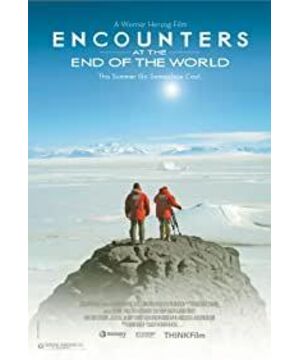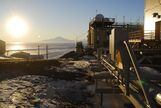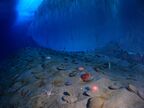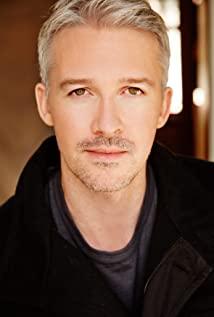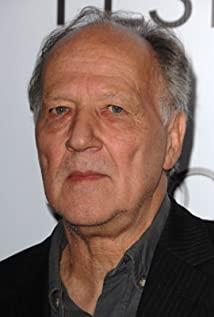1. Fly to the end of the world with three puzzles
When I heard the title of "Meet at the End of the World", my first reaction was a beautiful love story, and the background was a beautiful scenery that I might not be able to be there for the rest of my life.
I guessed wrong and I guessed right.
This documentary, Encounters at the End of the World, is an Antarctic documentary directed and voiced by Werner Herzog. It's not about love, but it's just as romantic and charming. Unlike other Antarctic-themed films, this time, his focus is not on penguins, but on people.
In the 100-minute film, the film crew departed from New Zealand, arrived at McMurdo Station on Ross Island by military aircraft, and then visited several large and small camps on Ross Island and the Antarctic mainland, interviewing truck drivers and forklift drivers. , glaciologists, chefs, survival training school guides, nutritional ecologists, physiologists, plumbing technicians, cell biologists, professional divers, volcanologists... More than a dozen "Antarctic residents".
Their journey seems unplanned, purely spontaneous, and the people interviewed are all like encounters—and that's what the "encounter" in the title is trying to convey.
During the journey to the magical white continent, Herzog pondered a few strange questions:
Why do humans always use masks or other things to hide their identities? Why do humans saddle horses and ride them to chase bad guys? Why don't higher animals like chimpanzees take advantage of lower animals? It can ride a goat in the sunset.
These puzzles about people and nature, like three invisible but tough fishing lines, connect all kinds of characters, animals and landscapes in the film, allowing the audience to glimpse the director's values in the extremely restrained audio and video. Herzog once said that every documentary he made was a feature film in disguise , and this one was no exception.
2. The "White Continent" and the Early Explorers
Antarctica, known as the Seventh Continent, is the last discovered and only uninhabited continent on Earth. More than 95% of its area is covered by extremely thick ice and snow, known as the "white continent". (--Baidu Encyclopedia)
Although tourism is becoming more and more popular, most ordinary people should never set foot in that icy world in their lifetime. By the way, last year, I joined a writing group with the goal of "Watching for ten years, and then going to Antarctica together" - because I was too lazy and especially afraid of the cold, I quit after a few days.
Black and white images of early explorers' Antarctic expeditions are repeatedly inserted into the film.
Ernest Shackleton and Robert Falcon Scott are famous figures of the heroic era of Antarctic exploration . In terms of results, they were not successful - Shackleton stopped 97 miles from the South Pole; Scott was second in the battle for "first man to reach the South Pole" with Norwegian explorer Amundsen, returning with extreme Weather, buried in the snow with teammates.
However, their stories of Antarctic expeditions have written an indelible stroke in the history of human exploration of nature - Shackleton was world-renowned for being the closest to the South Pole, and Scott's name was remembered in the world's highest dimensional science on the test station.
3. Hey, let's talk about dreams
This white continent, which was originally uninhabited, now accommodates more than 1,000 permanent residents.
They come from the vast "north" ; they have different skin colors, different identities; they carry different goals and different ideas.
However, there is a common temperament in these very different people - the temperament of professional dreamers.
So, let's take a look at what they talk about when they talk about dreams -
Dreamer No.1 Scott RowLand (Bus Driver)
The first to appear is the bus driver Scott who came to pick up the plane. He is driving one of only seven super buses in the world, traveling back and forth on the ice of Antarctica. Every journey is an adventure.
After two years as a bank clerk in Colorado, Scott joined the Peace Corps and traveled to Guatemala to help locals with small business projects. In the process, he realized that "it's not just money that matters in this world" .
One day, he was hunted down by six natives armed with machetes, who thought he was a child thief. At trial, he was acquitted. Later, he moved to Antarctica to start another dream journey. However, not long before he gave this interview, a woman was hunted down by the same group of people in the same place for taking a picture of a child and tragically died under a machete.
Life is impermanent, what we pursue is likely to die, just like Treadwell, the protagonist of "The Grizzly Man", is destined to die in the bear's paw.
Dying on the road of chasing dreams, is it a rightful death?
Dreamer No.2Stefan Pashov (philosopher, forklift driver)
Herzog and his party took the bus and gradually approached McMurdo Station - not the peaceful and peaceful wonderland, but the humble and crowded houses, the muddy roads, the chaotic and noisy construction sites - until they met Stefan Pashov, a shovel Driver and philosopher—the combination of these two identities may be peculiar in other places, but commonplace in Antarctica, because the people who land on this continent are all professional dreamers who have been selected by nature. , they tend to be full-time travelers and part-time workers.
Stefan is arguably the most worthy of the title of "professional dreamer". He said he had embarked on a fantasy journey at an early age, following the heroes of the Odyssey and Iliad as told by his grandmother, traveling through magical lands. He pursued it all the way to the point where the latitude and longitude converged - meeting other dreamers at "the end of the world". Stefan believes that daring to dream is one of the ways to promote the progress of reality, "the dream of the universe can only come true through the dream of the individual".
Dreamer No.3 Douglas MacAyeal (Glacier)
Douglas was with glaciers and icebergs day and night. During the day, he studied the iceberg. At night, he lay on the floating iceberg, listening to its low rumbling, feeling its powerful impact, and dreaming white dreams drifting north.
In the common sense of ordinary people, icebergs are just some huge ice cubes, and our most intuitive impression of them probably comes from the movie Titanic .
On the screen, we saw the white monster that overturned the largest ship in the world at that time and buried more than 1,500 people in the sea, but the iceberg touched by the Titanic was really only considered to be the huge Antarctic iceberg. "tip of the iceberg".
The iceberg Douglas is studying is not only bigger than the one that sank the Titanic, but also bigger than the Titanic itself, and even bigger than the country that built it! If all this iceberg melts, it can keep the Jordan River flowing continuously for 1000 years and the Nile River flowing continuously for 75 years!
Some ordinary things, if they become particularly large, its influence will exceed common sense, and even make people afraid.
Douglas speaks of flying over an iceberg in a plane - "Although the plane flies over the iceberg, the iceberg always overtakes us; it's high above it, looking down proudly, it's still an unsolved mystery to us" . I think that is probably the feeling of Sun Wukong trapped in Wuzhi Mountain.
It is worth noting that icebergs are not static, isolated behemoths, but active and dynamic life forms. They continue to rotate and drift with ocean currents, which will have unpredictable effects on the rest of the world.
Dreamer No.4Kavin Emery and his students
Before leaving the well-equipped McMurdo Station to venture out, everyone needs to participate in a two-day survival camp called Happy Campers.
Instructor Kavin Emery is a lean lad with a handsome, weathered face in an orange baseball cap and black sunglasses. He proficiently explained the strategies of survival in the polar regions in authentic American English, and instructed the students to simulate the scene of encountering a polar snowstorm.
In that weather, people not only have difficulty walking, but can't see or hear anything, and the trainees modeled it with white square plastic buckets with cartoon expressions on their head shields.
During the simulation, they leaned against each other with a rope, but when No. 1 went the wrong direction, No. 2, No. 3... also went astray; they realized their mistake and went back to the hut to start again. Deviating from "course" again.
Many times, even if we see with two eyes, we can't see clearly, and when we listen with two ears, we can't understand. So how far can we go without losing sight and hearing?
Dreamer No.5 Scientists who study seals
Nutritional ecologist Olav T. Oftedal and physiologist Regina Eisert are studying Weddell seals. These are some big, docile guys. They lay on the ice lazily basking in the sun, their blurred eyes revealing endless satisfaction.
Scientists are most interested in the physical changes in Weddell seals during lactation - in just a few weeks, as the pups grow, the mother seals lose 40% of their body weight! It is said that relevant research can solve the problem of weight loss that has long plagued human beings - this is really exciting news, ten years later, I wonder how they are doing now?
Compared to the chaos and noise of McMurdo, the seal research base is an extremely quiet place. Regina said she could often hear her own heartbeat. In addition, nature provides two sounds: one is the cracking sound of the ice surface, and the other is the chirping of seals under the ice - a wonderful sound of nature, similar to Pink Floyd's music, as if from another The world, let's imagine how nimble those bloated and cute guys are underwater, they chase, play, play, and enjoy the gifts of nature.
Dreamer No.6 David R. Pacheco, JR. (Plumbing Mechanic)
After visiting the seals, Herzog and his party returned to the boring McMurdo, and then met a person who was not boring - David Pacheco, a plumber. From the outside, he looks like an ordinary plumber, with dark blue work clothes wrapping the figure of a fat middle-aged man, doing seemingly boring work in a messy studio, but his red face is Unbelievable joy and pride.
In front of the camera, he keeps explaining his Apache ancestry, said to be a symbol of Indian royalty, and one of the physical proofs is that his middle finger is as long as his ring finger. He held his hands up for a long time, showing his pride.
We live in a hierarchical society. Wealth, status, fame, occupation... are all divided into three, six and nine, but these external labels do not define our entire life. Everyone can have their own pride and dreams. , even if it is only a long-standing and difficult to verify bloodline.
Dreamer No.7 Samuel S. Bowser (cell biologist), Jan Pawlowski (zoologist), Henry Kaiser (musician, professional diver)
The bitter cold of Antarctica cannot hinder the flourishing of life. There are alien humans and native animals; there are penguins and seals on land, and fish and shrimp in the water; huge icebergs constantly show the characteristics of dynamic life forms, and the microorganisms under the glaciers and in the deep sea also There is a terrifying power hidden in it.
Samuel talks about some creatures in the deep sea that wrap you in gooey bubbles or entangle you with long whiskers and eat them slowly, which is scarier than science fiction. The terrifying miniature world in the ocean that cannibalize each other may be one of the original driving forces for humans and mammals to climb on land.
With the help of modern diving equipment, people went deep into the ice sea and traced back to the earliest stages of the evolution of life.
As a sci-fi mystery, Samuel likes to show his colleagues doomsday sci-fi movies. Will humanity be destroyed? Will the earth fall into the hands of those evil beings? This is a question that scientists are always worrying about and exploring.
Through sample collection and experimental analysis, scientists have discovered 3 new species - a great moment witnessed in humble army green tents, and to celebrate with an open-air concert at perhaps the highest latitude ever .
Dreamer No.8 William Jirsa (linguist, computer expert)
In a small greenhouse, Herzog interviewed William Jirsa, a linguist with a mustache. Behind him was greenery, and immature tomatoes hung heavy on the branches.
A linguist came to a continent without language. Is this behavior of seeking fish out of the woods a kind of madness or a kind of despair? He dropped his Ph.D degree because he disagreed with mainstream academia on the protection of an endangered language.
As a linguist, William is heartbroken by the continued disappearance of language and the culture it carries. He mentions the shocking fact that 90% of language will disappear in his lifetime. He said he had a hard time imagining what the world would be like without Tolstoy after Russian literature died out—perhaps some people's world isn't complete, but life goes on.
The world is in a cycle of life and death every minute and every second. Every minute, a species is dying. During the time Herzog interviewed William, three or four languages disappeared from the face of the earth. This cultural level of "species extinction" has not received enough attention. Besides linguists and idealists like William, how many people would care about the demise of a language?
For a huge population of life and culture, life and death are common; however, we still need a dreamer like William who is devoted to cultural inheritance, because only cherishing can give meaning, for life, for culture The same is true.
Dreamer No.9 Travelers and explorers
When it comes to freedom and dreams, travel is an inescapable topic.
At the end of the world, behind every door there may be a special story.
Pushing open a false door, Karen Joyce was sitting in a chair painting a volcanic color painting. She has a weathered but innocent face, the typical traveler's face. In front of the camera, she talked about her past thrilling journey:
Traveled in Africa for four months in a garbage truck, stuck in the desert for five days, ate a plate and scraped wheels, was chased by a pack of angry elephants across a tsetse-fly-filled swamp, and traveled through the sewers from Ecuador to Lima, Peru , . . .
With such an experience, it is possible to come to the South Pole - there is infinite tolerance here, and freaks can dream unscrupulously.
"For those who crave freedom, travel means so much more."
Libor Zicha is a utility engineer and professional traveler. Although he is reluctant to talk about the past in detail, it is conceivable that, like Andy in "The Shawshank Redemption", the experience of breaking out of prison undoubtedly gave him a deeper understanding and desire for travel.
The best way to describe hunger is to describe a loaf of bread (and not be able to eat it). The best way to express freedom is to see freedom in front of you (but out of reach).
Libor is accustomed to traveling lightly. He packs his luggage at any time and is always ready to take risks and explore new areas.
Seeing this, I'm sure I've found the source of No. 14 of Herzog's 24 Life Advice "Light the fire inside and explore the unknown . "
What is the purpose of travel and exploration?
Different people have different answers. Early Antarctic explorers were obsessed with the glory of "being the first to set foot in Antarctica". Behind this obsession, there were primitive curiosity, the pursuit of personal fame, and the support of national honor.
Although the people interviewed earlier have different identities and goals, we can clearly feel that they went to Antarctica not for treasure hunting or fame, but for a more authentic self. Those who only pursue titles and labels, like Ashrita Furman, who live to break world records, end up with empty titles and labels.
Human beings have been exploring space, and Antarctica is the most space-like place on earth - quiet, pure, and uninhabited, and it is not as far away as space, not as lifeless as space, which makes it even more uniquely attractive. force.
Dreamer No.10 Retrograde Penguin
Herzog said that he didn't want to make a movie about penguins this time, but in the Antarctic, no one could ignore penguins, and the clip about penguins was the most moving part of this documentary.
David Ainley has been studying penguins for nearly 20 years, and he knows everything about penguins. He talked to Herzog about homosexuality, love triangles and sex trafficking in penguins. It sounded very "crazy" and strange, but even more strange was the penguin that looked "crazy".
It departed from the big group, away from the direction of the coast and its habitat, and walked towards the continuous Antarctic Transcontinental Mountains in the distance, into the depths of the vast continent, and the only end waiting for it was death. However, even if someone steered it back in the "correct" direction, it would still go back to the originally chosen route.
People use "crazy" and "lost" to explain the behavior of penguins. In fact, in the eyes of ordinary people, why not those who travel and adventure in Antarctica?
Dreamer No.11 William McIntosh (volcanologist, geochronologist), Clive Oppenheimer (volcanologist)
After experiencing the baptism of "ice", Nether Mountain - this fantastic name takes us into the world of "fire".
The crater is surrounded by clouds and mist, and the magma directly exposed to the surface may erupt at any time. At this time, safety becomes the first consideration. Experienced volcanologist William gave professional advice: face the lava lake, pay attention to its movements, try to see the "bomb" that is about to fall above your head, and then quickly dodge to the side, never hug the crater with your back Head off the string or get down. ——To avoid danger, you must first see the danger! This is the simplest and most simple wisdom, but it is also the blood and sweat experience of generations of pioneers of exploration.
This active volcano on Nether Mountain is relatively mild. In the history of the earth, violent volcanic eruptions have had a huge impact on the appearance of the earth, climate change, and even the origin and distribution of human beings.
Many scientists believe that the end of humanity on earth is bound to come:
Volcanic eruptions, climate change...will they trigger uncontrollable disasters?
Is human existence just one link in a series of cataclysms?
Dinosaurs are gone, will we be next?
If the fate of extinction cannot be reversed, the only thing we can do is to leave evidence of civilization, so that the alien archaeological team thousands of years later can imagine the glory of mankind in the past through the still relics.
When the world becomes a wasteland again, every flower and every grass deserves the most solemn commemoration. At the foot of the Nether Mountain, scientists built a "frozen altar" in the tunnel. In the exhibition frame surrounded by frozen popcorn, small flowers of various colors bloomed forever. The following card reads:
The flower's here for you to smell came from far and wide to this frozen hell, mom, friends, grandmas, great-aunts, and such. They look nice and did not cost too much.
It's just that when we haven't lost these beautiful things that don't cost too much, we often turn a blind eye to them.
Dreamer No.12 Peter Gorham (physicist, neutrino project leader)
There is a visible world and an invisible world.
The world of neutrinos is such an invisible world.
Physicists have confirmed their existence through intelligent brains and sophisticated instruments.
During the first few seconds of the Big Bang, neutrinos were the dominant particles that dictated the production of elements that shaped the universe as we know it today.
These particles have successfully retreated, silently reclusive in the space where we live, like ghosts or gods, untouchable, but everywhere.
How many unknowns are there in this world, waiting for us to explore?
Fourth, the end
As the film draws to a close, our philosopher and forklift driver is on camera again.
He quotes the philosopher Aaron Swartz as saying:
It is through our eyes that the universe understands itself. It is through our ears that the universe hears its own harmony. We are witnesses to the universe through which we perceive our own glory and splendor.
This 100-minute documentary, this real and magical trip to Antarctica, is more shocking than a Hollywood sci-fi blockbuster.
Nature, life, the universe, there are too many unknowns waiting for us to explore.
For those who are committed to exploring the unknown, life will never fall into mediocrity, because every day is full of adventure.
View more about Encounters at the End of the World reviews


